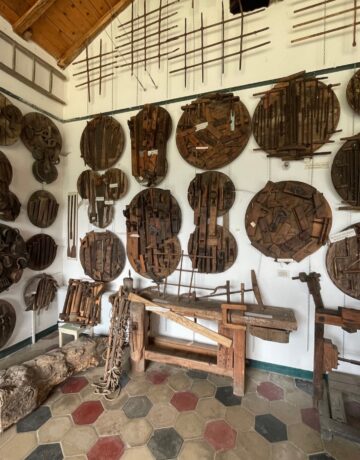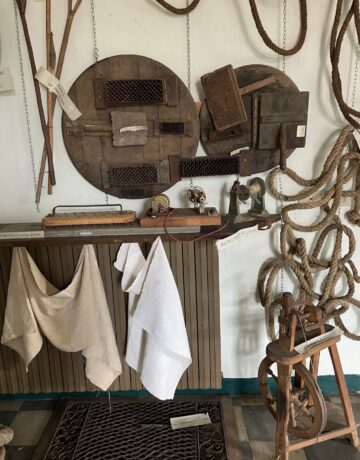Ironworking and Textile Art
By accessing the first floor of the anthropological exhibition, on the left, it is possible to enjoy the first environment which is dedicated to the primary iron and wood processing in the pre-industrial period, while the second space is dedicated to the advent of electricity that came next.
Room 1
E ven at that time, iron metallurgy was involved in the treatment of high iron content minerals in order to obtain and then process iron. After the extraction, this metal took the form of blocks that had to be then laboriously forged by bar or by mold. Forging took place inside forges, where the metal was made malleable by overheating it through the combustion of coal which was fed by bellows, the handheld fans of the past. It was therefore possible to give the piece the desired shape for the creation of artifacts.
ven at that time, iron metallurgy was involved in the treatment of high iron content minerals in order to obtain and then process iron. After the extraction, this metal took the form of blocks that had to be then laboriously forged by bar or by mold. Forging took place inside forges, where the metal was made malleable by overheating it through the combustion of coal which was fed by bellows, the handheld fans of the past. It was therefore possible to give the piece the desired shape for the creation of artifacts.
Starting from the entrance of room number 1, clockwise, you can see many equipment used in work processes, nails, axes, pliers, saws, drills, wagon wheels, many hammers and so on, are shown. They were used for countless activities, such as agriculture, carpentry, construction and for common use.
Also in the same room, on the wall with the opening towards the attic, you can admire the tools, with which the hands of skilled carpenters, have given life to the wood that, from chestnut and beech trees, become rustic furniture (arte povera ) and objects of daily use.
Among the countless tools stand out the planer used to size and give more precision to the raw piece, the spatula for spread the putty, the gouge to carve manually the wood and the lathe to give it the desired shape. Among the most original equipment, we find “lo spinacino“, a special tool used to obtain shading from inlaid figures. These craft products were then often prepared so that they could be painted and waxed. All these objects are traces of the past and of the historical customs and traditions.
Room 2
 Proceeding into the next room number 2, you can appreciate some of the very first electrical components for the transmission and use of electric current. In this room, you can also admire the art of basketry and hemp and linen processing.
Proceeding into the next room number 2, you can appreciate some of the very first electrical components for the transmission and use of electric current. In this room, you can also admire the art of basketry and hemp and linen processing.
Hemp, cultivated in Italy until the mid-1900s, was used for the production of ropes, fishing nets, but especially for the production of household linen.
In 1938 Italy became the worldwide leader in the cultivation of this plant. Until the end of the 1940s, hemp fiber fabric was advertised as the only lightweight but robust and at the same time hygienic yarn, in fact it was called “the fabric that lasts 100 years” due to its resistance.
Four months after sowing, in the period of March-April, the flax harvest takes place; the flax plant is not mowed but uprooted to preserve the length of the fibers contained in its stem.
After uprooting, the flax is left on the ground so that the rain and the sun, together with the bacterial microorganisms present in the plant, create fermentation, allowing a natural separation of the fibers from the woody part. At this point the fibres can be extracted, cleaned and combed to separate the long ones from the short ones, so the linen can be spun.
As far as environmental sustainability is concerned, flax and hemp crops do not require pesticides, fertilizers and defoliants that would end up the aquifers.
During the growth of these plants, a useful process of carbon dioxide absorption is activated and in addition, there is no water consumption because no irrigation is needed. Furthermore hemp and flax regenerate the soil in which they grow, they are biodegradable and compostable. Moreover, nothing is discarded in either fiber, what is not used for textile sector, is utilized as a secondary raw material for the production of paper and also as a substitute for fiberglass in construction.
In the corner of the room, between the two openings, is positioned a complete equipment used in the past by the fire brigade for emergency blaze intervention.
